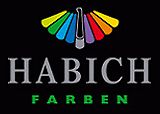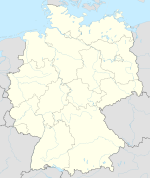Habich colors
Coordinates: 51 ° 29 ′ 34 ″ N , 9 ° 36 ′ 23 ″ E
Habich colors (GE Habich's Sons GmbH & Co. KG) is a manufacturer of colors in Veckerhagen, a district of the municipality of Reinhardshagen in the district of Kassel , Hesse . The manufacturing facilities are located directly on the banks of the Weser , south of the former hunting lodge Veckerhagen ( Habich's Schloss ), which also belongs to the company .
history
Founding years
In 1785 the Kassel pharmacist Karl Wilhelm Fiedler took over the previously "Landgräflich-Hessische" saltpeter boiler at the Wesertor in Kassel . This date is considered to be the year of birth of today's paint factory Habich, which is therefore much older than the chemical giants Bayer and BASF , which were founded in 1863 and 1865 respectively. In 1791 the merchant Georg Evert Habich, with three other partners, took over the rather run-down business and began to mix mineral colors. The Medical Faculty of the University of Göttingen soon praised the quality of its products such as salmiak , Glauber's salt and colors. The painters' colors - mineral Kassel and Brunswick green , yellow, brown-red and, a little later, Berlin blue and linen blue - quickly gained in importance compared to other chemicals such as salmiac, saltpeter and potash , and Habich became known for its particularly bright green, yellow and blue .
Relocation to Veckerhagen
In 1810, Habich bought the hunting lodge in Veckerhagen, built in 1689 and the unused dilapidated Old Castle , from the then King Jérôme Bonaparte von Westphalen for 2000 Reichstaler, and began to set up production facilities in the castle and in and on the remains of the old castle. A little later, his sons August Heinrich, Christian Evert and Johann Martin took over the business, which still included businesses in Kassel and Mönchehof . After further expansion of the plant in Veckerhagen, they completely relocated their company GE Habich's Söhne there in 1823 and manufactured chemicals and paints there.
Lignite mining
In 1834 the company acquired the lignite colliery at Gahrenberg , 6 km southwest of Veckerhagen, opened it up from 1842 with a 250 m tunnel and from 1842 to 1970 mined lignite in underground mining, which covered the energy needs of the paint factory in Veckerhagen and also for house fire the population delivered. At the same time, the lubricating or colored charcoal required for color production was also mined, which was used to produce the Kassel brown and nut pickle, which were dried on the old castle floor from 1865 onwards . The stain was used all over the world to give wrapping paper its typical brown color. Also alum was won on the earth Gahrenberg that of pharmacists and for dyeing and tanning was needed.
Years of growth
With the gradual development of the railway network in Germany from the middle of the 19th century, the company in Veckerhagen threatened to slip into a peripheral location in terms of traffic, because their products still had to be transported to Kassel by three-headed horse and carts . This disadvantage could not be remedied until 1882 when the Fulda bridge was connected to the rail network in 1856 . Münden was built and the goods could be brought to the train station there. At the beginning of the 20th century, transport was quickly switched to trucks .
The machine park and product range expanded considerably in the period that followed. Koller for mixing of color mixtures, mills and steam engines were installed. The chrome yellow was created in the cellar of the former castle , in the color mill above the Hemelmühle, where the former "Blue Mouse" barbecue area was built after its abandonment, was ground black and the Kassel brown was dried in the factory yard and the old castle floor. Acid barrels and chemicals were stored in the castle. Sales soared. New products, natural earth colors , tar dyes , chrome - and zinc paints , varnishes as Lithol (from 1910), coal tar dyes, is rubbed ink (from 1912) and wallpaper colors (from 1921), came into range.
1914-1945
A factory fire in 1914, large parts of Altenburg destroyed the First World War , the post-war inflation and the 1929 onset of the global economic crisis caused severe setbacks, but Friedrich Habich expanded the company after the war further out, mobilized the old customer base in Italy and Egypt and served new markets in South America.
Production continued during the Second World War , but production almost came to a standstill, as Junkers Flugzeug- und Motorenwerke set up an armaments factory on part of the company premises, which considerably restricted Habich's production.
Post-war upswing and today's situation
After the war, the paint factory got back on its feet primarily with the delivery of large quantities of olive to the paint factory Schramm-Lacke in Offenbach for the vehicles of the American occupation forces. In 1955 the company brought dry colors to the market, both as inorganic earth and mineral colors, which have a great naturalness, as well as chemical pigments with a striking luminosity, which are used in the restoration sector , by artists and when coloring cement or concrete . 1959 began the production of emulsion paints . In 1967 the still considerable remains of the old castle fell victim to another major fire; the remaining foundation walls were used to build new workshops and warehouses. In 1970 lawn marking paints for sports fields were added to the product range. In 1975, new liquid colors , paste colors and color granulates with a plastic component were introduced for the plastics industry . Wall glazes for DIY enthusiasts have been on offer since 2000 .
Today about 117 employees produce paints, emulsion paints, lawn marking paints and color granulates. A particular specialty are colors for coloring plastic parts.
The lignite mine at Gahrenberg, in which 30 to 40 workers mined between 15,000 and 20,000 t annually , was shut down on October 30, 1970 after the last shift . The conveyor systems were then almost completely demolished and the tunnel entrance closed. In December 1970 the chimney was blown up and the last open tunnel collapsed. The boiler house, which was last used by the Gahrenberg forestry depot (Hessenforst), was demolished in December 2007, the former Steigerhaus in 2008.
Web links
literature
- 200 years GE Habich`s Sons, Veckerhagen. Paint factory on the way through two centuries. Edited by GE Habich's Sons, Veckerhagen, 1985
- Paul Adolf Kirchvogel: 175 years of GE Habich's sons Veckerhagen. From the history of a German paint factory. Edited by GE Habich's Sons, Veckerhagen, 1960
- Friedrich Habich: Habich's factory in Veckerhagen and the brown coal works on Gahrenberg. Heimatjahrbuch Landkreis Hofgeismar, Hofgeismar, 1929





